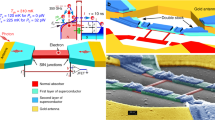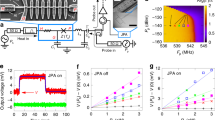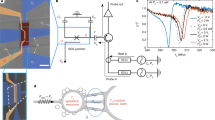Abstract
The submillimetre or terahertz region of the electromagnetic spectrum contains approximately half of the total luminosity of the Universe and 98% of all the photons emitted since the Big Bang1. This radiation is strongly absorbed in the Earth's atmosphere, so space-based terahertz telescopes are crucial for exploring the evolution of the Universe2,3. Thermal emission from the primary mirrors in these telescopes can be reduced below the level of the cosmic background by active cooling, which expands the range of faint objects that can be observed. However, it will also be necessary to develop bolometers—devices for measuring the energy of electromagnetic radiation—with sensitivities that are at least two orders of magnitude better than the present state of the art. To achieve this sensitivity without sacrificing operating speed, two conditions are required. First, the bolometer should be exceptionally well thermally isolated from the environment; second, its heat capacity should be sufficiently small. Here we demonstrate that these goals can be achieved by building a superconducting hot-electron nanobolometer. Its design eliminates the energy exchange between hot electrons and the leads by blocking electron outdiffusion and photon emission. The thermal conductance between hot electrons and the thermal bath, controlled by electron–phonon interactions, becomes very small at low temperatures (∼1 × 10−16 W K−1 at 40 mK). These devices, with a heat capacity of ∼1 × 10−19 J K−1, are sufficiently sensitive to detect single terahertz photons in submillimetre astronomy and other applications based on quantum calorimetry and photon counting.
This is a preview of subscription content, access via your institution
Access options
Subscribe to this journal
Receive 12 print issues and online access
$259.00 per year
only $21.58 per issue
Buy this article
- Purchase on Springer Link
- Instant access to full article PDF
Prices may be subject to local taxes which are calculated during checkout




Similar content being viewed by others
References
Blain, A. W., Smail, I., Ivison, R. J., Kneib, J.-P. & Frayer, D. T. Submillimetre galaxies. Phys. Rep. 369, 111–176 (2002).
Benford, D. J., Amato, M. J., Mather, J. C., Moseley, S. H. & Leisawitz, D. T. Mission concept for the single aperture far-infrared (SAFIR) observatory. Astrophys. Space Sci. 294, 177–212 (2004).
Bradford, C. M. & Nakagawa, T. The future is BLISS — sensitive far-IR spectroscopy on SPICA and SAFIR. New Astron. Rev. 50, 221–227 (2006).
Langley, S. P. The bolometer and radiant energy. Proc. Am. Ac. Arts Sci. 16, 342–358 (1881).
Sergeev, A. V., Mitin, V. V. & Karasik, B. S. Ultrasensitive hot-electron kinetic-inductance detectors operating well below superconducting transition. Appl. Phys. Lett. 80, 817–819 (2002).
Day, P. K., LeDuc, H. G., Mazin, B. A., Vayonakis, A. & Zmuidzinas, J. A broadband superconducting detector suitable for use in large arrays. Nature 425, 817–821 (2003).
Komiyama, S., Astafiev, O., Antonov, V., Kutsuwa, T. & Hirai, H. A single-photon detector in the far-infrared range. Nature 403, 405–407 (2000).
Meschke, M., Guichard, W. & Pekola, J. P. Single-mode heat conduction by photons. Nature 444, 187–190 (2006).
Schmidt, D. R., Schoelkopf, R. J. & Cleland, A. N. Photon-mediated thermal relaxation of electrons in nanostructures. Phys. Rev. Lett. 93, 045901 (2004).
Ojanen, T. & Heikkila, T. T. Photon heat transport in low-dimensional nanostructures. Phys. Rev. B 76, 073414 (2007).
Schwab, K., Henriksen, E. A., Worlock, J. M. & Roukes, M. L. Measurement of the quantum of thermal conductance. Nature 404, 974–977 (2000).
Schwab, K. Quantum physics: information on heat. Nature 444, 161–162 (2006).
Kenyon, M., Day, P. K., Bradford, C. M., Bock, J. J. & Leduc, H. G. Progress on background-limited membrane-isolated TES bolometers for far-IR/submillimeter spectroscopy. Proc. SPIE 6275, 627508 (2006).
Karasik, B. S., McGrath, W. R., LeDuc, H. G. & Gershenson, M. E. A hot-electron direct detector for radioastronomy. Supercond. Sci. Technol. 12, 745–747 (1999).
Gershenzon, E. M., Gershenzon, M. E., Goltsman, G. N., Semyonov, A. D. & Sergeyev, A.V. Heating of electrons in a superconductor in the resistive state by electromagnetic radiation. Zh. Eksp. Teor. Fiz. 86, 758–773 (1984) [Sov. Phys. JETP 59, 442–450 (1984)].
Wellstood, F. C., Urbina, C. & Clarke, J. Hot-electron effects in metals. Phys. Rev. B 49, 5942–5955 (1994).
Karasik, B. S. et al. Record low NEP in the hot-electron titanium nanobolometers. IEEE Trans. Appl. Supercond. 17, 293–297 (2007).
Andreev, A. F. The thermal conductivity of the intermediate state in superconductors. Zh. Eksp. Teor. Fiz. 46, 1823–1828 (1964) [Sov. Phys. JETP 19, 1228–1231 (1964)].
Wei, J. Hot-Electron Effects, Energy Transport and Decoherence in Nano-systems at Low Temperatures. PhD thesis, Rutgers Univ. (2007).
Sergeev, A. V. & Mitin, V. Electron–phonon interaction in disordered conductors: Static and vibrating scattering potentials. Phys. Rev. B 61, 6041–6047 (2000).
Karvonen J. T. & Maasilta I. J. Influence of phonon dimensionality on electron energy relaxation. Phys. Rev. Lett. 99, 145503 (2007).
Gershenson, M. E., Gong, D., Sato, T., Karasik, B. S. & Sergeev, A. V. Millisecond electron–phonon relaxation in ultrathin disordered metal films at millikelvin temperatures. Appl. Phys. Lett. 79, 2049–2051 (2001).
Irwin, K. D. An application of electrothermal feedback for high resolution cryogenic particle detection. Appl. Phys. Lett. 66, 1998–2000 (2005).
Karasik, B. S. & Sergeev, A. V. THz hot-electron photon counter. IEEE Trans. Appl. Supercond. 15, 618–621 (2005).
Semenov, A. D. et al. Terahertz performance of integrated lens antennas with a hot-electron bolometer. IEEE Trans. Microwave Theory Tech. 55, 239–247 (2007).
Irwin, K. D. Seeing with superconductors. Sci. Am. 295, 86–92 (November 2006).
Roukes, M. L. Yoctocalorimetry: phonon counting in nanostructures. Physica B 263–264, 1–15 (1999).
Leinhert, Ch. et al. The 1997 reference of diffuse night sky brightness. Astron. Astrophys. Suppl. Ser. 127, 1–99 (1998).
Acknowledgements
We thank J.H. Kawamura at JPL/Caltech for help with the experiments. The work at Rutgers was supported in part by the National Aeronautics and Space Administration (NASA) grant NNG04GD55G, the Rutgers Academic Excellence Fund, and the NSF grant ECS-0608842. The research at the Jet Propulsion Laboratory, California Institute of Technology, was carried out under a contract with NASA. The work at SUNY at Buffalo was supported by NY STAR and NATO grants.
Author information
Authors and Affiliations
Corresponding authors
Rights and permissions
About this article
Cite this article
Wei, J., Olaya, D., Karasik, B. et al. Ultrasensitive hot-electron nanobolometers for terahertz astrophysics. Nature Nanotech 3, 496–500 (2008). https://doi.org/10.1038/nnano.2008.173
Received:
Accepted:
Published:
Issue Date:
DOI: https://doi.org/10.1038/nnano.2008.173
This article is cited by
-
Thermal Conductance of Titanium Hot-Electron Bolometers with Different Microbridge Thicknesses
Journal of Low Temperature Physics (2023)
-
Experimental evaluation of thermal rectification in a ballistic nanobeam with asymmetric mass gradient
Scientific Reports (2022)
-
A room-temperature polarization-sensitive CMOS terahertz camera based on quantum-dot-enhanced terahertz-to-visible photon upconversion
Nature Nanotechnology (2022)
-
Plasmonic semiconductor nanogroove array enhanced broad spectral band millimetre and terahertz wave detection
Light: Science & Applications (2021)
-
Graphene-based Josephson junction microwave bolometer
Nature (2020)



